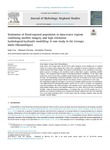Estimation of flood-exposed population in data-scarce regions combining satellite imagery and high resolution hydrological-hydraulic modelling: A case study in the Licungo basin (Mozambique)

View/
Use this link to cite
http://hdl.handle.net/2183/32220
Except where otherwise noted, this item's license is described as Atribución-NoComercial-SinDerivadas 3.0 España
Collections
- Investigación (ETSECCP) [826]
Metadata
Show full item recordTitle
Estimation of flood-exposed population in data-scarce regions combining satellite imagery and high resolution hydrological-hydraulic modelling: A case study in the Licungo basin (Mozambique)Date
2022Citation
Cea, L., Álvarez, M., Puertas, J. (2022). Estimation of flood-exposed population in data-scarce regions combining satellite imagery and high resolution hydrological-hydraulic modelling: A case study in the Licungo basin (Mozambique). Journal of Hydrology: Regional Studies, 44, 101247.
Abstract
[Abstract:] Study Region
Licungo basin (Mozambique)
Study Focus
The Licungo basin (23,263 km2) suffers frequent severe flooding due to tropical storms, in a country that is among the world’s most vulnerable in terms of exposure to weather-related hazards and climate change. We propose a methodology for the estimation of the population exposed to flooding at the catchment scale in data-scarce regions, combining satellite imagery with integrated high-resolution hydrological-hydraulic modelling. All the input data needed are retrieved from freely-available global satellite products. The numerical model is also freeware. The methodology is therefore replicable worldwide. An estimate of the flood extent and exposed population during Tropical Storm Ana (January 2022) is presented as a case study.
New Hydrological Insights for the Region
Current freely-available satellite products in combination with high-resolution hydrological-hydraulic models can be used to estimate the population exposed to flooding in the whole catchment. This estimate is more realistic than the one obtained using satellite imagery alone, since satellite images are very rarely taken at the time of maximum flooding. Using the proposed methodology, we estimate that over 273,000 people (out of 1.5 million) were exposed to flooding in the Licungo basin during Tropical Storm Ana. This represents 18% of the basin population and is 8 times larger than the estimate obtained using only the available satellite images.
Keywords
Tropical storms
Flood hazard
Global digital elevation models
Sentinel-1 imagery
Iber model
Data-scarce regions
Flood hazard
Global digital elevation models
Sentinel-1 imagery
Iber model
Data-scarce regions
Description
Financiado para publicación en acceso aberto: Universidade da Coruña/CISUG
Editor version
Rights
Atribución-NoComercial-SinDerivadas 3.0 España






